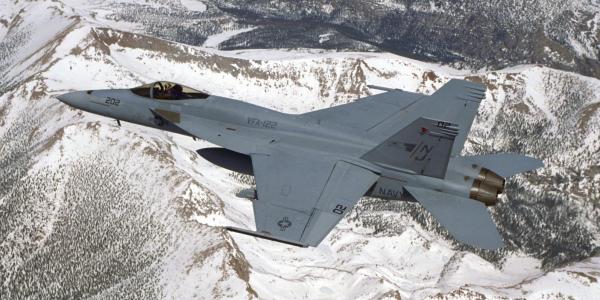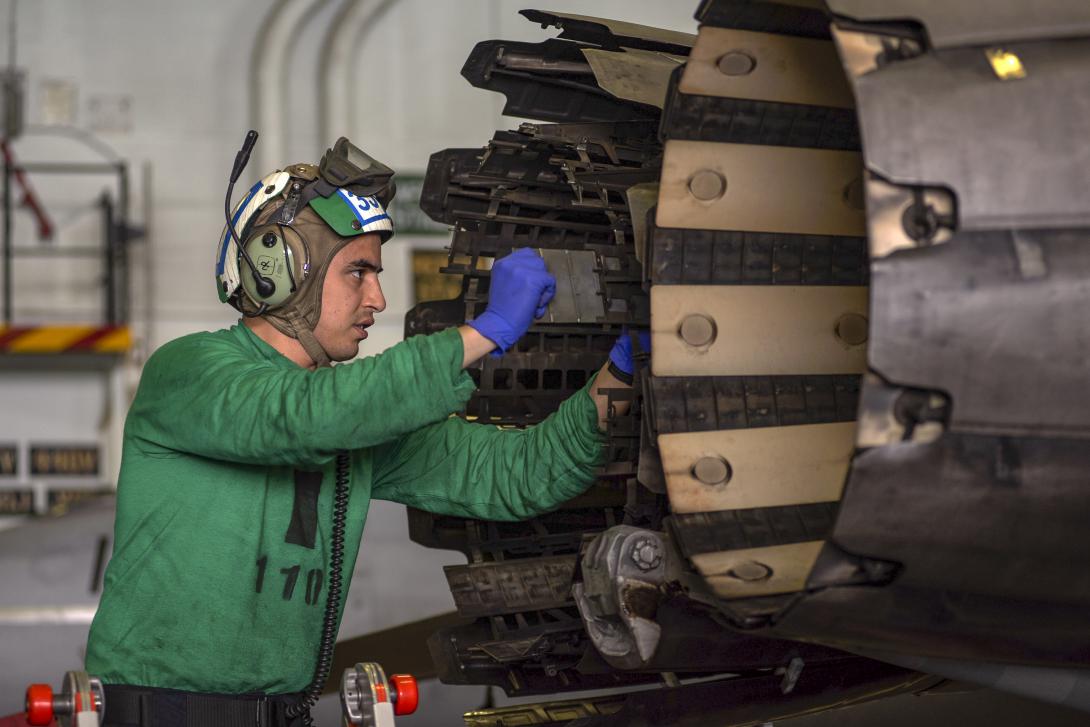Navy Raises Anchor on Blockchain
A prototype U.S. Navy program is turning to blockchain technology to help track aviation parts throughout their life cycles. The approach automates what is now a mostly manual process and provides aircraft maintenance personnel with accurate, detailed information about each part’s origins and order/reorder status.
The project is a cooperative research and development agreement (CRADA) between the Naval Air Systems Command’s (NAVAIR’s) Fleet Readiness Center Southwest’s Advanced Technologies Team at the Coronado Naval Air Station in San Diego, and Indiana Technology and Manufacturing Companies (ITAMCO) in South Bend, Indiana. A key goal of the proof-of-concept project is to change how the Navy tracks aircraft parts for its fleet of F-18 Hornet multirole fighter jets. Currently, once parts have been delivered to the service, they are tracked with pen and paper then the information is manually entered into a database.
Under the CRADA, NAVAIR will use the Simple Blockchain Applications (SIMBA) Chain, a blockchain technology ITAMCO originally developed for a Defense Advanced Research Projects Agency (DARPA) program. The project eventually spun off into SIMBA Chain Inc.
The DARPA project awarded to ITAMCO and the University of Notre Dame involved developing a secure message tracking system for the U.S. Army. Applying a similar approach, the Navy hopes to achieve increased traceability and visibility for its F-18 fleet with additional benefits through improved safety and lower costs.
SIMBA Chain has modified its blockchain technology to mesh with a variety of NAVAIR procurement systems such as material tracking and quality management. By connecting these systems and using a smart contract or blockchain format, the capability also allows NAVAIR to continue operations without substantially modifying its current business systems, says Joel Neidig, CEO, SIMBA Chain Inc.
“Now we don’t have to change anything about the current way they do business or how their systems work. But we can now harness the power of blockchain and have that traceability and reliability,” he maintains.
The SIMBA Chain blockchain platform is designed to work in U.S. government Microsoft Azure .gov cloud environments. This compliance allows the system to run across a variety of federal agency environments, Neidig says.
While interest about blockchain’s potential within the U.S. Defense Department is growing, some cultural issues and misconceptions remain relating to blockchain-based technologies and how they can work in a government setting, he explains. One of these areas is governance. Unlike a cryptocurrency such as Bitcoin where the user and “owners” of the blockchain and its data are completely decentralized, in a Defense Department application, only the communications and the individual nodes in that system are truly decentralized while the overall governance is centralized.
Although SIMBA Chain uses blockchain technology as a decentralized ledger, it is not a token platform such as a cryptocurrency like Bitcoin, Neidig says. The underlying technology in the blockchain is called a smart contract, which involves computer protocols designed to digitally facilitate or verify the negotiation and enforcement of a contract.
A key part of smart contracts is that they allow transactions such as ordering aircraft parts to be carried out automatically without the need for a third party. For the Defense Department, all the details and operational capabilities, including logistics management, are decided, modified or revised before they are loaded into the software supporting the blockchain. However, when the blockchain itself is deployed, it is issued in a fault-tolerant way. This allows for centralized management of the overall system such as a logistics operation while making the entire network resilient to denial-of-service attacks or intruder attempts to change transactions.
Blockchains can prevent data from being manipulated or stolen because each transaction or link in the chain is encrypted, known as hashed, by a set of unique characters derived from information contained inside that block. Every addition to the chain has its own unique encrypted hash, so any unauthorized changes break the encryption or alter its data and immediately stand out.
“The hashes are what’s connecting those blocks on the blockchain. A hash can change a previous time stamp or whatever else is in that data block from a previous block, and that’s how they maintain the trust of the data,” Neidig says.
This is important for logistics management programs such as the NAVAIR F-18 maintenance program. Neidig says the Navy’s goal is to ensure the material processes are correctly carried out, a foreign manufacturer has not made any of the material and some other adversarial party has not entered the supply chain.
Because blockchains provide complete traceability of parts, they also are potentially useful for Defense Department contract management. Neidig notes that contract management within the government and large defense contractors is very complex. Many large programs are a mix of different agencies, contractors and subcontractors, all with varying security and access levels to classified and unclassified information.
SIMBA Chain’s built-in management layer allows program managers to define and assign the user roles of groups and individuals in a project. As a result, access and transaction rules and other permissions can be added or excluded, allowing security and access/identity management to be built into a process from the beginning.
The SIMBA Chain was originally developed for a DARPA program aimed at managing interdepartmental military purchase requests. Neidig explains SIMBA Chain was able to define all the relationships and architecture to automate the process. This process is Defense Federal Acquisition Regulation Supplement, or DFARS, compliant to prevent fraud.
The blockchain also helps accelerate the process because smart contracts are executable code and are “essentially binding contracts that happen on the blockchain.” This coding means order requests are carried out automatically. Neidig notes that SIMBA Chain participated in a Defense Department war game, and the armed forces in the game could use the blockchain system to order and reorder parts and equipment and were automatically fulfilled.
“The defense contractors would be paid, the original manufacturers would be paid, all along the way. All those addresses are in the smart contract to automatically execute, and the money gets distributed. But then it’s a digital ledger, so it not only gets [carried out] logistically, but financially it’s all connected, verified and reconciled,” he says.
Currently, much of the Navy’s aircraft maintenance logistics are done at least partially on paper, or the information is handwritten and then put into the software system manually. By moving to a fully digitized system, the process of supporting warfighters is more efficient, ensuring they get the right supplies in a timely manner, Neidig says.
In addition to NAVAIR and the Army, SIMBA Chain has Small Business Innovation Research agreements with the U.S. Air Force and the Department of Energy. The Air Force uses blockchain to streamline the design management process for additive manufacturing projects, which lends itself to blockchain because the design and development process is already fully digital, Neidig says.
The process begins with a computer-aided design model that is then sent electronically to a 3D printer to create a physical object. Managing this process via blockchain introduces security and management control into the process, he says.
The SIMBA Chain’s ability to securely invite other organizations to participate in a project also helps with cross-agency collaboration and information sharing. This is a unique capability in the government space, Neidig says.
“The cool thing is that it’s all blockchain, and it’s all compliant with the smart contracts and the auditability and capabilities there. It really lends itself well for those government agencies to interact with each other in ways that they normally don’t,” he shares.
The NAVAIR program is still in its early stages with the initial architecture and some proof-of-concept development underway. Neidig expects more functions to be added as the program moves forward, but the initial groundwork is still being laid down, he says.
The program officially launched in October 2018, and its initial phase will run for one year. There will be follow-on phases that will include production and operational implementations after the first year.






Comments